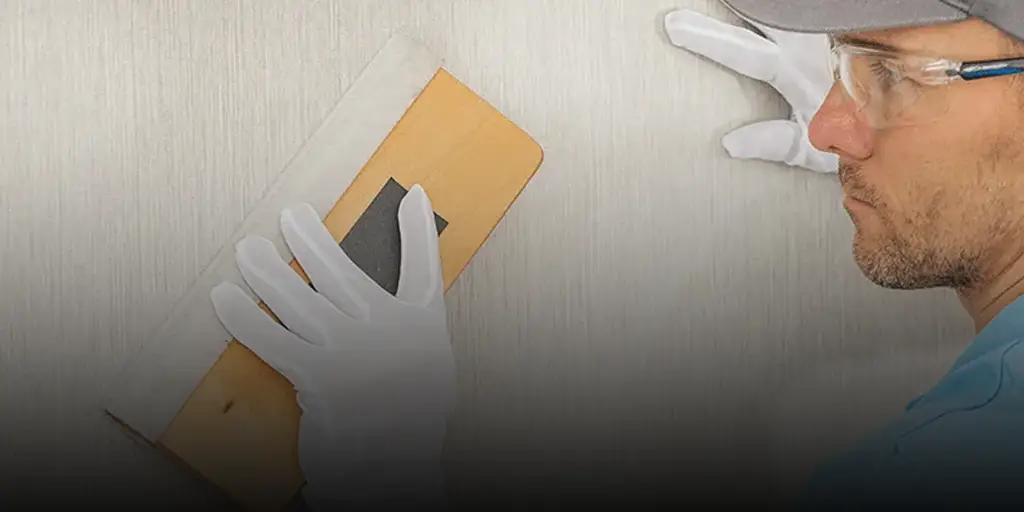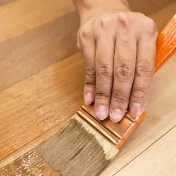When embarking on a painting project, one critical question often arises: “Do you have to prime before painting?”
The short answer is, it depends on various factors like the nature of the surface, the paint type, and the project’s specific requirements.

Priming is a preparatory step that can significantly impact the longevity and appearance of your paint job.
In this guide, we delve into the nuances of when and why priming is essential, focusing on porous surfaces, color transitions, and more.
Whether you’re patching up a small area with spackle or joint compound or tackling a full room, understanding the role of primer is key to achieving high-quality and effective results with your paint.
Knowing Primer and Why It’s Important
Primer serves more than just a base coat; it’s the foundation that ensures your regular paint adheres correctly and reveals its true potential.
On porous surfaces like bare drywall or patched or repaired drywall, primer helps seal the surface and prevent multiple coats of paint from soaking in unevenly.
It’s also crucial when transitioning from a dark color to a light color, ensuring that the new hue displays vibrantly without requiring excessive layers of paint.
For the discerning painting professional, choosing whether to use a separate primer or a paint-primer combination can make all the difference in the success of the painting project.
From oil-based options to the latest high-quality paint primers on the market, the choice of primer can be as important as the paint itself.
The Role of Primer on Porous Surfaces

When it comes to painting porous surfaces like bare drywall or wood, the question isn’t “Do you have to prime before painting?” but rather “How can you afford not to?”
Porous materials naturally absorb paint, leading to uneven coverage and an increased need for multiple coats of paint. This is where primer comes in as a game-changer.
Sealing Porous Surfaces
A coat of primer seals these surfaces, creating a uniform base that ensures consistent paint absorption.
This is particularly important when dealing with newly installed drywall or areas patched with spackle or joint compound.
Without priming, these patches can appear as unsightly blotches, as the paint absorbs differently on patched areas compared to the rest of the wall.
Enhancing Paint Adhesion
Beyond improving appearance, priming porous surfaces enhances paint adhesion, reducing the likelihood of peeling or blistering over time.
High-quality primers are designed to bond with the surface and form a solid foundation for the paint, ensuring that your painting project remains durable and visually appealing.
Economical Benefits
While it may seem like an extra step, priming actually saves time and resources in the long run. A properly primed surface requires fewer coats of regular paint, reducing the overall amount of paint needed and ultimately saving on costs.
On porous surfaces, skipping the primer can lead to suboptimal results and additional expenses. Investing in a good primer is essential for a professional, long-lasting finish.
Transitioning Between Dark and Light Colors

A common challenge in painting projects is transitioning from a dark color to a light one. Without the right preparation, achieving a crisp, clean, light color over a dark base can be a daunting task.
This is where the strategic use of primer becomes invaluable.
The Necessity of a Primer Coat
When painting over a dark color with a lighter one, applying a coat of primer first can drastically reduce the number of paint coats needed.
Primer masks the darker shade, providing a neutral base that allows the light color to shine through with its true vibrancy.
This is especially true for colors with less pigment, such as pastels or off-whites, which might otherwise require multiple coats of regular paint to achieve the desired opacity.
Choosing the Right Primer Shade
For significant color changes, consider using a tinted primer. A primer tinted closer to your final paint color can greatly improve coverage and reduce the number of topcoats required.
This approach is both time-saving and cost-effective, ensuring your painting project proceeds smoothly.
Ensuring Even Coverage
In addition to aiding in color transition, a primer helps ensure even coverage and a uniform finish. This is particularly important for areas that have been patched or repaired, as these might absorb paint differently than the rest of the wall.
When transitioning from a dark to a light color, skipping the primer step can result in uneven color, additional work, and unnecessary expense.
A well-chosen primer can make the process more efficient and lead to a more polished and professional result.
Addressing Stains and Repairs
Dealing with stains or areas that have been patched or repaired is a critical aspect of any painting project. In such scenarios, priming is not just recommended; it’s essential for achieving a flawless finish.
Primer as a Stain Blocker
Stains from water damage, smoke, or markers can bleed through regular paint, marring the appearance of your walls. A high-quality primer effectively blocks these stains, ensuring they don’t resurface over time.
Oil-based primers, in particular, are excellent for sealing in stains and preventing them from affecting the topcoat.
Seamless Integration of Repairs
For walls that have undergone repairs, patches of spackle or joint compound can absorb paint differently than the rest of the wall, leading to an uneven look.
Applying a coat of primer over these repaired areas ensures that they blend seamlessly with the rest of the wall.
This uniformity is crucial for a professional-looking finish, as it prevents repaired spots from standing out.
Selecting the Right Type of Primer
Different types of stains and repairs may require specific primers. For instance, oil-based primers are generally more effective against water and smoke stains, while latex-based primers can be sufficient for minor repairs and general priming needs.
It’s important to select a primer that’s compatible with both your wall’s condition and the type of paint you’re using.
In essence, proper priming is a vital step in covering stains and integrating repaired areas into your painting project.
It ensures that the final coat of paint looks consistent and stays true to its intended appearance, free from any underlying imperfections.
Priming Smooth Surfaces for Optimal Adhesion
Painting smooth surfaces like glass, plastic, metal, or laminate presents unique challenges. These non-porous surfaces often resist paint adhesion, leading to peeling or flaking over time.
Here, the role of primer is pivotal in ensuring the paint adheres properly and lasts longer.
Creating a Bondable Surface
Primers designed for smooth surfaces are formulated to create a bondable surface for the paint to adhere to. They work by etching slightly into the surface or providing a textured layer for the paint to grip onto.
This is particularly important for surfaces like metal or plastic, where regular paint alone might easily chip or peel away.
Types of Primers for Smooth Surfaces
For these challenging surfaces, specialized primers are available. Oil-based primers are often preferred for their durability and adhesion qualities.
There are also primers specifically designed for certain materials, such as galvanized metal or PVC. Choosing the right primer for your specific surface type is crucial for the success of your painting project.
Application Tips
When applying primer to smooth surfaces, it’s important to follow a few key steps:
- Clean the surface thoroughly to remove any grease, oil, or dust.
- Lightly sand the surface if possible, to improve adhesion.
- Apply a thin, even coat of primer, following the manufacturer’s instructions.
Properly priming smooth surfaces ensures that your paint job will not only look better but will also withstand the test of time.
Primer and Odor Control
In addition to preparing surfaces for painting, primers can play a crucial role in controlling odors.
Whether dealing with smoke, pet odors, or the lingering smell of cooking, the right primer can effectively seal in these unwanted smells, ensuring they don’t permeate through the new paint.
Types of Odor-Blocking Primers
Odor-blocking primers are specially formulated to seal in and neutralize odors. These are typically oil-based or shellac-based and are known for their superior odor-sealing capabilities.
They work by creating a barrier that prevents odors from passing through, ensuring that your new paint layer remains fresh and odor-free.
Application in Smoke or Pet Odor Situations
In situations where a room has been affected by smoke or pet odors, a regular primer might not be sufficient. Using an odor-blocking primer can make a significant difference.
It’s particularly effective in scenarios such as houses that have experienced fire damage or rooms that have been heavily exposed to cigarette smoke.
Health and Safety Considerations
While odor-blocking primers are highly effective, they often contain more potent chemicals than regular primers.
It’s important to use them in well-ventilated areas and to follow all safety guidelines on the product label.
Additionally, for those with sensitivities to chemicals, there are now more eco-friendly options available that are low in volatile organic compounds (VOCs) but still effective at odor blocking.
For painting projects where odor control is a concern, investing in a high-quality, odor-blocking primer is key.
It not only ensures a better end result but also contributes to a healthier and more pleasant living environment.
Environmentally Friendly Priming Solutions
In today’s environmentally conscious world, the impact of painting products on both health and the environment is a growing concern.
Thankfully, advancements in paint technology have led to the development of eco-friendly primers that offer effective performance without compromising on health or environmental standards.
Low-VOC and Zero-VOC Primers
Volatile Organic Compounds (VOCs) are chemicals found in many traditional primers that can release harmful gases into the air, affecting indoor air quality and posing health risks.
Low-VOC and zero-VOC primers are designed to minimize these emissions, providing a safer option for both the environment and your home.
They are particularly beneficial in enclosed spaces or in homes with children, pets, or individuals with chemical sensitivities.
Natural and Bio-Based Primers
Another emerging trend is the use of natural and bio-based primers. These products are made from renewable resources and are designed to be biodegradable, further reducing their environmental impact.
While they might be a newer addition to the market, these eco-friendly options are proving to be both effective in performance and beneficial for sustainable practices.
Performance Considerations
While eco-friendly primers are a great choice for those looking to reduce their environmental footprint, it’s important to consider the specific needs of your painting project.
Some eco-friendly primers may perform differently than traditional formulas, particularly in terms of drying time or coverage.
It’s crucial to select a product that aligns with both your environmental values and the requirements of your painting project.
The use of environmentally friendly primers is a step towards more sustainable painting practices.
They offer a responsible choice for those who are mindful of health and environmental impacts without sacrificing quality or performance.
People Who Want to Read This Article:
Selecting the Right Primer for Your Project
Choosing the appropriate primer is a pivotal decision in any painting project.
With various types of primers available, each suited to different surfaces and purposes, understanding how to select the right one is key to ensuring a successful and lasting paint job.
Identifying the Surface Type
The first step in choosing a primer is to identify the surface you will be painting. Different materials — such as wood, drywall, metal, or previously painted surfaces — require different types of primers.
For instance, porous surfaces like bare drywall or wood benefit from a primer that seals the surface, whereas metal surfaces require a primer that prevents rust and improves adhesion.
Considering the Paint Type
The type of paint you plan to use also influences your primer choice. Oil-based paints generally work best with oil-based primers, while latex paints are compatible with latex primers.
However, there are now multi-surface primers available that are versatile and can be used with different paint types.
Special Conditions
In cases where you’re dealing with stains, drastic color changes, or high-moisture areas, specialized primers are necessary.
Stain-blocking primers are ideal for covering water or smoke stains, while primers designed for bathrooms or kitchens offer mold and mildew resistance.
Eco-Friendly Options
For those looking for environmentally friendly choices, low-VOC and zero-VOC primers are available. These options are especially important for indoor projects or in settings where air quality is a concern.
The right primer will not only ensure better paint adhesion and longevity but also enhance the overall appearance of your paint job.
Take the time to assess your project’s specific needs and choose a primer that best suits those requirements.
Best Practices in Primer Application
Applying primer correctly is just as important as selecting the right one.
Proper application ensures maximum effectiveness of the primer, leading to better adhesion, durability, and overall appearance of the paint job. Here are some best practices to follow when applying primer:
Surface Preparation
- Cleaning: Ensure the surface is clean and free of dust, dirt, and grease. This may involve washing the walls or using a degreaser on surfaces like kitchen walls.
- Sanding: For glossy surfaces, lightly sanding helps to create a texture for the primer to adhere to.
- Repairs: Fill any holes or cracks and sand them smooth before priming.
Primer Application
- Tools: Use the right tools for the job. Brushes work well for small areas and corners, while rollers are ideal for larger surfaces. For some surfaces, a sprayer might be the best option.
- Even Coats: Apply the primer in thin, even coats. This prevents drips and ensures the primer dries evenly and quickly.
- Drying Time: Allow the primer to dry completely before applying paint. Drying times can vary based on the type of primer and environmental conditions.
Safety Precautions
- Ventilation: Ensure good ventilation, especially when using oil-based or stain-blocking primers.
- Protective Gear: Use gloves, masks, and eye protection as needed, particularly in poorly ventilated areas or when sanding.
Testing
- Spot Test: Before priming the entire surface, do a spot test in an inconspicuous area to ensure compatibility and desired results.
Following these steps will help ensure that your primer is applied effectively, creating the ideal base for your painting project and ensuring long-lasting, professional results.
Conclusion
In conclusion, understanding the intricacies of “Do you have to prime before painting?” is essential for any painting project.
Whether dealing with porous surfaces, aiming for a drastic color change, covering stains, or ensuring paint adhesion on smooth surfaces, the right primer can make a significant difference.
It’s not just about laying a foundation for the paint but also about ensuring durability, uniformity, and the true representation of the chosen paint color.
Primers come in various formulations to meet different needs, from eco-friendly options to those specifically designed for stain blocking or odor sealing.
The key is to choose a primer that aligns with the specific requirements of your project and to apply it following best practices.
Remember, a well-executed priming process can save time and resources in the long run, and it’s a step that shouldn’t be overlooked.
By investing in the right primer and applying it correctly, you’re setting the stage for a painting project that looks professional and lasts longer.
As we’ve seen through real-life examples, the power of a good primer can transform any space, making it a crucial element in the toolkit of both DIY enthusiasts and professional painters alike.



